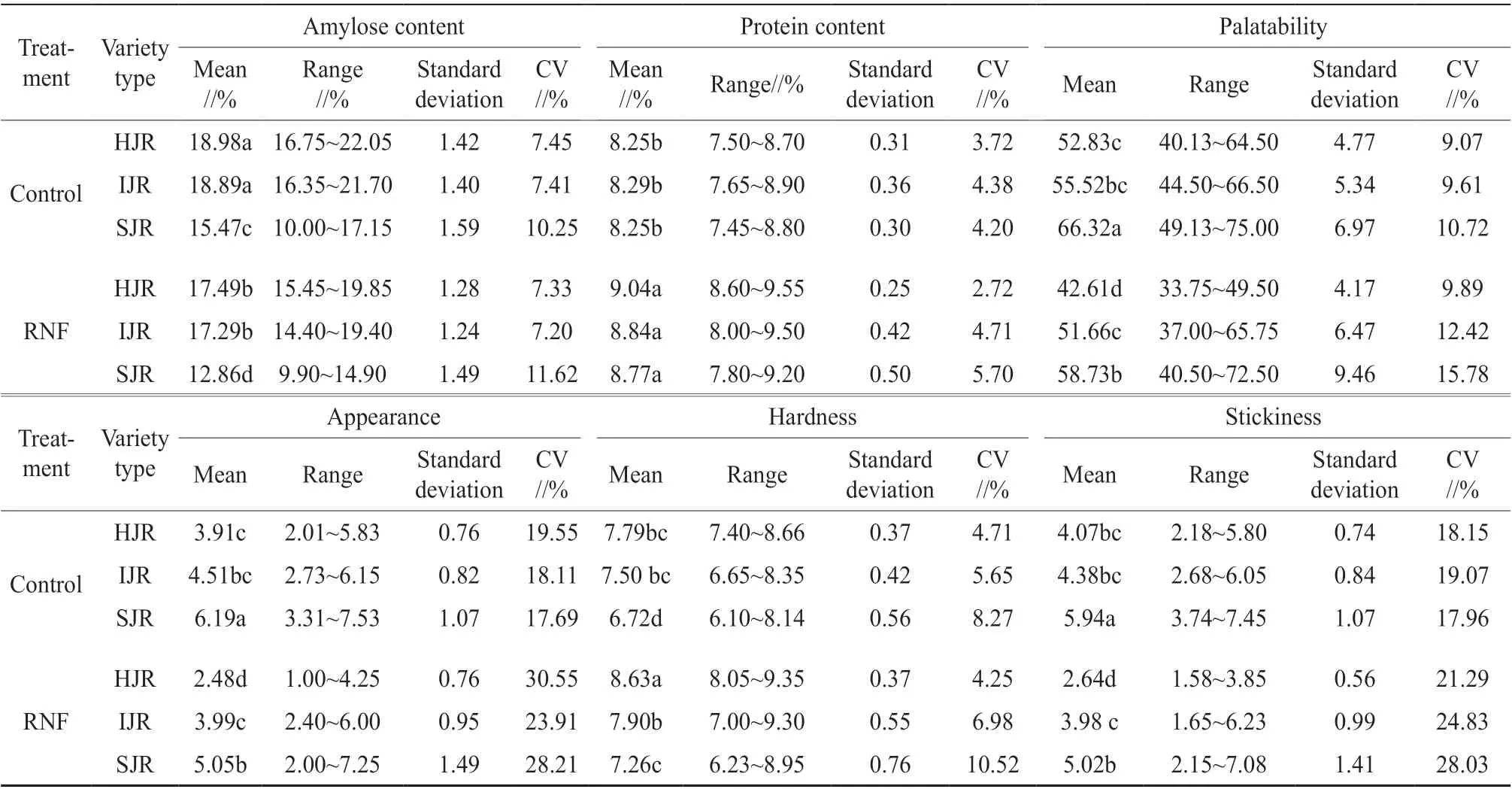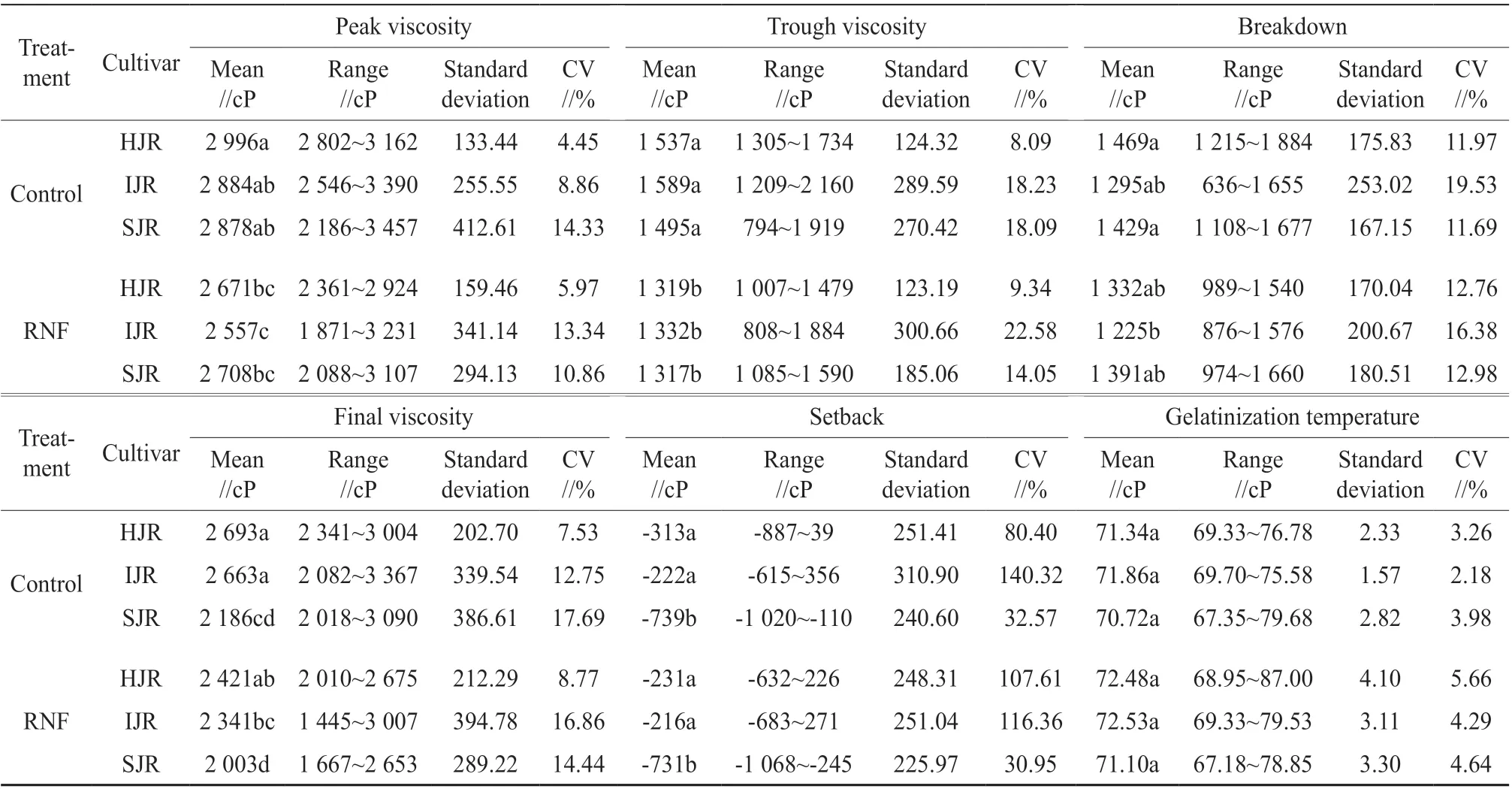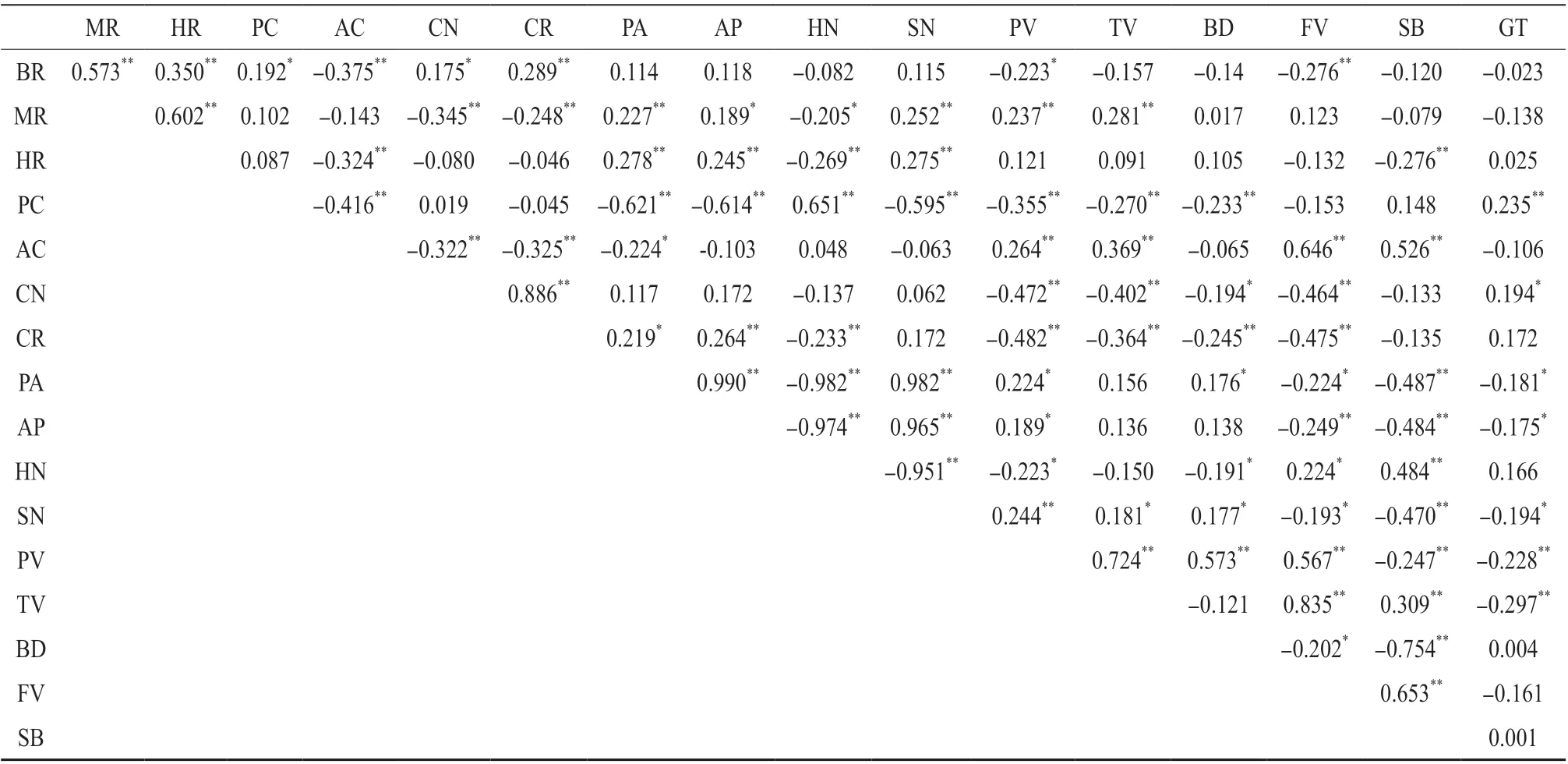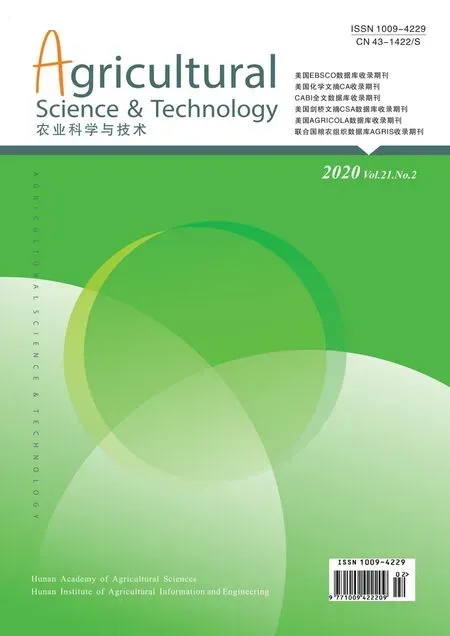Effects of Nitrogen Fertilizer on Grain Quality of Different Cultivars of Japonica Rice
HU Ya-jie, XUE Jian-tao, LI Luan, YU En-wei, NI Jia-hao, XING Zhi-peng, GUO Bao-wei
Agricultural College of Yangzhou University, Jiangsu Key Laboratory of Crop Cultivation and Physiology, Co-Innovation Center for Modern Production Technology of Grain Crops, Yangzhou 225009, PRC
Abstract Three cultivars of Japonica rice: hybrid Japonica rice, inbred Japonica rice and soft Japonica rice, were used to study the effects of recommended nitrogen fertilizer on grain quality including milling, appearance, nutrition, cooking and eating quality, pasting property and their relationships in direct seeding rice. Recommended nitrogen fertilizer improved the brown rice rate, the milled rice rate, and the protein content; increased the chalky grain rate and the chalkiness, and reduced the amylose content, palatability and pasting viscosity. The nitrogen fertilizer caused the appearance, the cooking and the eating quality to deteriorate. Lower amylose content and protein content were found in soft Japonica rice compared to those in hybrid Japonica or inbred Japonica rice under the condition of the recommended rate of nitrogen fertilizer, contributing to high cooking and eating quality. Correlation analysis indicated that palatability was negatively correlated with amylose content, protein content, hardness and gelatinization temperature, and was positively correlated with stickiness, peak viscosity and breakdown. Therefore, the decreased amylose and protein content of the soft Japonica rice cultivar planted under the condition of the recommended rate of nitrogen fertilizer is beneficial to achieving high taste quality.
Key words Nitrogen fertilizer; Grain quality; Japonica rice; Palatability; Pasting viscosity
1. Introduction
Rice (Oryza sativa L.) is one of the most important cereal crops in Asia. In China, it is a staple food for about 2/3 of the population[1]. From 1949 to 2017, rice production in China more than tripled, from 48.65 million t in 1949 to 208.56 million t in 2017, due to the development of semi-dwarf and hybrid rice varieties and improved rice cultivation and management[2-3]. Recently, reformation of the cereal grain supply was proposed due to a national cereal grain surplus. Nowadays, the demand for high quality rice is rapidly increasing. The focus has shifted from quantity to quality. Some soft Japonica rice varieties with good taste have been released in China, such as Nanjing 46, Nanjing 5055, Nanjing 9108, Nanjing 505, Nanjing 2728 and Suxiangjing 100, which have lower amylose content (5%~15%) and better eating quality after cooking[4]. Previous research showed that hybrid Japonica rice had yield superiority over inbred Japonica rice or soft Japonica rice[5-6]. However, there has been limited research comparing soft Japonica rice, inbred Japonica rice and hybrid Japonica rice.
Direct seeding rice is different from transp- lanting rice; due to the benefits of less labor, reduced production and high efficiency, the adoption of direct seeding by farmers is widespread[7-8]. In addition, the increase in net income from direct seeding result from not having to raise and transplant seedlings is attractive to farmers. For this reason, direct seeding of rice has gradually become the main method of rice planting in China. The benefit of direct seeding is earlier crop establishment, making for comparative grain yield compared to transplanting rice[7]. The grain quality of direct seeding rice is degraded compared to traditional transplanting rice due to abnormal maturation and reduction in the duration of time the rice head has to become grain-filled[9]. The length of the growing period is a primary determinant of yield and grain quality. The total growth period of direct seeding rice is shortened compared to transplanting rice as the seedling date is delayed, resulting in a reduction in the yield and a lowered grain quality. Hence, improving the grain quality of direct seeding rice would be a good topic for further research.
In addition to the length of the growing period, adequate nitrogen is a major factor affecting rice yield and grain quality. In order to achieve good grain yield, farmers are accustomed to increasing the amount of nitrogen they apply, making China the largest nitrogen consumer in the world[10]. However, excessive nitrogen, rather than enhancing the yield, leads to worse grain quality[11]and low nitrogen usage efficiency[12]. Numerous field experiments have shown the appearance, cooking and eating quality of rice worsened under the condition of high nitrogen application, whereas the milling quality and nutritional quality improved[13]. Currently, the taste or palatability of cooked rice is focused on by rice breeders and agronomists. The protein content and amylose content are the main factors determining the taste quality of rice. In general, the palatability of rice is negatively related to the protein content and the amylose content. To improve the palatability of cooked rice, rice varieties with low protein content and low amylose content were bred and cultivated. However, increased nitrogen input could also reduce the amylose content and enhance the protein content of rice.
Previous studies on the grain quality of different rice cultivars were comparative analyses of transplanting rice[14-15]. There has been little comparison of grain quality and its components among direct seeding hybrid Japonica rice, inbred Japonica rice, and soft Japonica rice. Therefore, the aim of this study was to determine the differences in the characteristic and the components of the grain quality in direct seeding hybrid Japonica, inbred Japonica, and soft Japonica rice in response to nitrogen fertilizer.
2. Materials and Methods
2.1. Plant materials and growth conditions
Field experiment was conducted in a paddy field of Shengao Town, Jiangyan County, Jiangsu Province, China in 2016. The cropping system was the wheatrice rotation system. The soil in the paddy fields was clay with 27.1 g/kg organic matter, 1.8 g/kg total N, 18.9 mg/kg Olsen-P, 95.2 mg/kg available K.
25 hybrid Japonica lines, 24 inbred Japonica lines, and 16 soft Japonica lines were used in this experiment (Table 1). Seeds of all lines were collected from Jiangsu Academy of Agricultural Sciences (Nanjing, Jiangsu Province), Tianjing Academy of Agricultural Science (Tianjing), Ningbo Academy of Agricultural Sciences (Ningbo, Zhejiang Province), Wujing Rice Research Institute (Wujing, Jiangsu Province), Shenyang Agricultural University (Shenyang, Liaoning Province), and NanjingAgricultural University (Nanjing, Jiangsu Province).

Table 1 Rice cultivars and lines used in the experiment
2.2. Treatment
The rice was grown in rice-wheat rotation; that is, wheat was planted after harvesting rice, rice was sowed after harvesting wheat. The experiment was arranged in randomized block. Two nitrogen treatments were adopted in this experiment, including a control (0 kg/hm2) and recommended nitrogen fertilizer (RNF, 225 kg/hm2). Seeds were sowed on Jun 13th. The rate of sowing was 60 kg/hm2. The size of each subplot was 12 m2(4 m×3 m). The experiment was conducted in three replicates. Phosphorus (80 kg/hm2as single superphosphate) and potassium (120 kg/hm2as KCl) were applied and incorporated before direct sowing under two forms of nitrogen application. Under the recommended nitrogen fertilizer condition, basal nitrogen (90 kg/hm2as urea) was applied and incorporated before direct sowing, a top dressing of nitrogen was also applied at the tillering (90 kg/hm2as urea), panicle branch differentiation (45 kg/hm2as urea). Water, weeds, insects, and diseases were controlled as required to avoid yield loss.
2.3. Grain quality measures
Rice grains harvested from each treatment were dried naturally until the moisture of the grain was 14% and then stored at 4°C for 3 months. Rice quality analy- sis was performed according to GB/T 17891—1999.
2.3.1. Milling quality
Rice grains were allowed to pass through a dehusker to obtain brown rice. The brown rice was polished for milled rice. Head rice with grain length greater than 3/4 of its total length was separated from milled rice. The brown rice rate, milled rice rate and head rice rate were expressed as percentages of the total grain weight.
2.3.2. Appearance quality
Chalkiness was evaluated on 100 milled grains per plot. The number of grains containing over 20% white were considered as the chalkiness rate. Chalkiness size was expressed as percentage of the total area of the kernel.
Chalkiness degree (%) = Chalkiness rate × Chalkiness size
2.3.3. Nutrition, cooking and eating quality
Protein content and amylose content were measured with a grain analyzer. Cooking and eating quality was measured by Taste Analyzer RCTA11A.
2.3.4. Pasting property
Milled rice was grounded into flour. Analysis of the rice flour pasting property was carried out by Rapid Viscosity Analyzer.
2.4. Statistical analysis
Data were analyzed using Microsoft Excel 2013 and SPSS 17.0. The analysis of variance and mean comparison were based on the least significant difference (LSD) test at the P<0.05 probability level.
3. Results
3.1. Milling quality
Difference in the milling quality existed in different cultivars under the nitrogen fertilizer treatment. Compared with the control, the brown rice rate and milled rice rate of all three cultivars slightly increased under the recommended nitrogen fertilizer treatment. The head rice rate for the soft Japonica rice increased, whereas it decreased for the hybrid Japonica rice and the inbred Japonica rice (Table 2). Regardless of with or without nitrogen fertilizer, the milling quality improved significantly in soft Japonica rice compared to that in hybrid Japonica rice. The traits of the milling quality in the inbred Japonica rice were comparable with those in the soft Japonica rice and in the hybrid Japonica rice (Table 2).
3.2. Appearance quality
Compared to those under the control, the chalkiness and the chalky grain rate increased for the three cultivars under RNF, but there was no significant difference between the two nitrogen treatments (Table 3). Hybrid Japonica rice had lower chalkiness and chalky grain rate than inbred Japonica rice and soft Japonica rice in control or in RNF did. The chalkiness and the chalkiness grain rate increased slightly in soft Japonica rice than in inbred Japonica rice under two nitrogen levels (Table 3).

Table 2 Difference in milling quality of different cultivars of direct seeding rice

Table 3 Difference in appearance quality of different rice cultivars in direct seeding rice
3.3. Nutrition quality
The protein content increased significantly for different rice cultivars under RNF compared to the control (Table 4). In the same nitrogen condition, there was no significant difference in the protein content among the three cultivars, nevertheless, soft Japonica rice had slightly lower protein content than inbred Japonica rice or hybrid Japonica rice under RNF.
3.4. Cooking and eating quality
The amylose content was one of key indicators of cooking and eating quality. For the three cultivars, the amylose content was significantly lower under RNF than that under the control (Table 4). Regardless of nitrogen fertilizer, soft Japonica rice had a lower amylose content than hybrid Japonica rice and inbred Japonica rice did.
The taste quality was measured after the rice was cooked. Compared to the control, the palatability diminished significantly under RNF except for inbred Japonica rice (Table 4). Soft Japonica rice had remarkably higher palatability than inbred Japonica rice and hybrid Japonica rice under the control or RNF. The palatability increased significantly in inbred Japonica rice compared to hybrid Japonica rice under RNF. The appearance and stickiness was reduced significantly under RNF compared to the control except for inbred Japonica rice (Table 4). The hardness increased markedly under RNF compared to the control except for inbred Japonica rice. Regardless of nitrogen fertilizer, soft Japonica rice had obviously higher appearance and stickiness and significantly lower hardness than inbred Japonica rice and hybrid Japonica rice.
3.5. Pasting property
The pasting property of rice flour correlated with cooking and eating quality. Compared to those under control, peak viscosity, trough viscosity, final viscosity and breakdown were reduced for the three cultivars under RNF, whereas setback and gelatinization temperature increased (Table 5). Regardless of nitrogen treatment, the final viscosity and setback was reduced significantly in soft Japonica rice compared to those in inbred Japonica rice and hybrid Japonica rice (Table 5). There were no differences in peak viscosity, trough viscosity, breakdown and gelatinization temperaturebetween the hybrid Japonica rice, inbred Japonica rice and soft Japonica rice.

Table 4 Difference in nutritional quality and cooking and eating quality of different cultivars of direct seeding rice

Table 5 Difference in pasting properties of different rice cultivars in direct seeding rice
3.6. Relationships among rice qualities
Table 6 showed that correlations among milling quality (i.e. brown rice rate, milled rice rate, head rice rate), appearance quality (i.e. chalkiness, chalkiness grain rate), nutrition quality (protein content) and cooking and eating quality (i.e. amylose content, palatability, hardness, stickiness and pasting property). The cooking and eating quality (palatability) was significantly positively correlated with milling quality (milled rice rate and head rice rate), appearance quality (chalkiness grain rate). Protein content was significantly negatively correlated with palatability, and amylose content was weakly negatively correlated with palatability, whereas protein content was significantly negatively correlated with amylose content. The property of cooked rice (stickiness) and the parameters of pasting (peak viscosity and breakdown) were significantly positively correlated with palatability, whereas hardness, final viscosity, setback and gelatinization temperature were significantly negatively correlated with palatability. Hence, good tasting rice should have a low protein content, low amylose content, low hardness, low final viscosity, low setback, low gelatinization temperature and high milling quality, high stickiness, high peak viscosity, and high breakdown.
4. Discussion
Nitrogen fertilizer affects grain quality. The application of nitrogen fertilizer increases the milling recovery and the head rice ratio[16-17]. In this study, the nitrogen fertilizer slightly increased the brown rice rate and the milled rice rate of the three cultivars, whereas the head rice rate differed among the three in response to the nitrogen fertilizer (Table 2). Generally, the milling quality, including the head rice rate, was improved by increased nitrogen fertilizer.
Various factors influence appearance. In this study, nitrogen fertilizer increased the chalkiness and the chalky grain rate of all three cultivars (Table 3). These results were in agreement with previous study reporting that increased nitrogen fertilizer caused the appearance to deteriorate[14]. There were differences in chalkiness and chalky grain rate between the hybrid Japonica rice, the inbred Japonica rice and the soft Japonica rice. The chalkiness and the chalky grain rate increased more in the soft Japonica rice than in the inbred Japonica rice or the hybrid Japonica rice.Compared to the inbred Japonica rice or the hybrid Japonica rice, the soft Japonica rice had worse appearance regardless of with or without nitrogen fertilizer.

Table 6 Correlation coefficient among rice qualities of different rice cultivars in direct seeding rice
The nitrogen fertilizer increased the protein content and decreased the amylose content for all tested cultivars (Table 4). Several researchers have also observed the increase of protein content and the reduction of amylose content of rice grain in response to nitrogen fertilizer or increased nitrogen fertilizer[17-18]. Of the three tested cultivars, soft Japonica rice had significantly lower amylose content than hybrid Japonica rice and inbred Japonica rice, with or without nitrogen fertilizer. The protein content of the hybrid Japonica rice, inbred Japonica rice and soft Japonica rice was comparable under the control condition, whereas the soft Japonica rice had slightly lower protein content than the hybrid Japonica rice or the inbred Japonica rice did under the nitrogen fertilizer treatment (Table 4). Previous researches have established that cooking and eating quality is determined by factors including amylose content, protein content, gel consistency and pasting property[19-20]. The amylose content and protein content were negatively correlated with palatability (Table 6). In other words, both low amylose content and low protein content contributed to high palatability. In this study, higher palatablity was found for all three cultivars under the control condition, compared to those under recommended nitrogen fertilizer treatment (Table 4). Correlation analysis showed that appearance and stickness were postively correlated with palatablity, whereas hardness was negatively correlated with palatablity (Table 6). Compared to those under the control condition, nitrogen fertilizer increased the hardness and decreased the appearance and stickiness (Table 4). We also observed that soft Japonica rice had the highest palatablity under the control condition (Table 4), due to both low protein content and low amylose content. Therefore, cooked rice with high palatablity had a low protein content and a low amylose content, resulting in decreased hardness and increased stickiness.
Pasting property was closely correlated to cooking and eating quality, depending on rice grain protein content and amylose content and their interaction. Previous researches have shown that increased protein content resulting from nitrogen fertilizer application could reduce the peak and breakdown viscosity while increasing the pasting temperature[21-22]. In this study, the same results were found that nitrogen fertilizer increased the gelatinization temperature and reduced the peak viscosity (Table 5). Trough viscosity, final viscosity and breakdown decreased differently for different cultivars under recommended nitrogen fertilizer treatment compared to those under the control conditions, whereas nitrogen fertilizer increased the setback (Table 5). High peak viscosity and breakdown, small setback resulted in the benefits of being soft, sticky and having good taste[23]. Therefore, nitrogen fertilizer could cause the pasting property to deteriorate, contributing to lower cooking and eating quality. Of the three tested cultivars, soft Japonica rice had higher peak viscosity and breakdown and lower setback and gelatinization temperature than inbred Japonica rice or hybrid Japonica rice did under recommended nitrogen fertilizer treatment (Table 5). The high cooking and eating quality of the soft Japonica rice was attributable to its low protein content and low amylose content, leading to the superiority of its pasting property and high palatability.
5. Conclusion
Compared with the control, application of the recommended nitrogen fertilizer improved the milling quality except for the head rice rate and nutrition quality, and caused the appearance and the cooking and eating quality to deteriorate. As for the cultivars, soft Japonica rice had a higher cooking and eating quality than either hybrid Japonica rice or inbred Japonica rice did, due to its low amylose content and protein content and its high pasting viscosity. Correlation analysis showed that the palatability was negatively correlated with the amylose content, protein content, hardness and gelatinization temperature, and was positively correlated with stickiness, peak viscosity and breakdown. Therefore, breeders and agronomists could achieve high cooking and eating quality of rice by screening and breeding rice for both low amylose content and low protein content.
 Agricultural Science & Technology2020年2期
Agricultural Science & Technology2020年2期
- Agricultural Science & Technology的其它文章
- Analysis on Some Agronomic Characters and Pedigree in Hezihao Series Peanut Varieties
- A Study on Planting Adaptability of Various Soybean Varieties in Hengyang
- Analysis of Rhizosphere Microbial Community Structure in Different Pathogenesis Stages of Watermelon Fusarium Wilt
- Study on Extraction Method of Carotenoids from Citrus Leaves
- Investigation of Salt Stress Response Mechanisms Using Mirna Sequencing of Salt Tolerant and Salt Sensitive Jute Genotypes
- Optimization of Steam Explosion Process Condition for Extracting Polysaccharides from Pseudostellaria heterophylla by Response Surface Methodology
